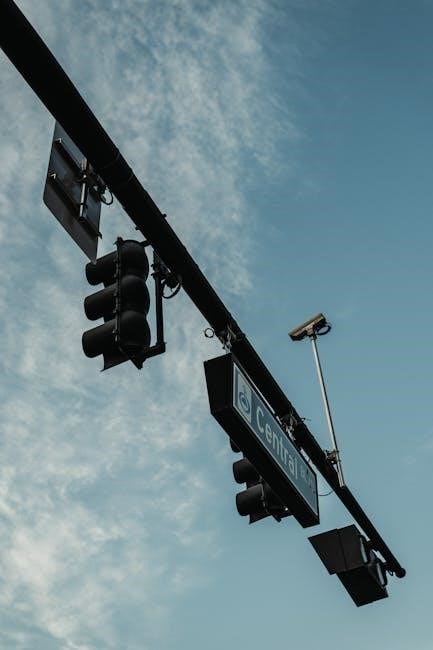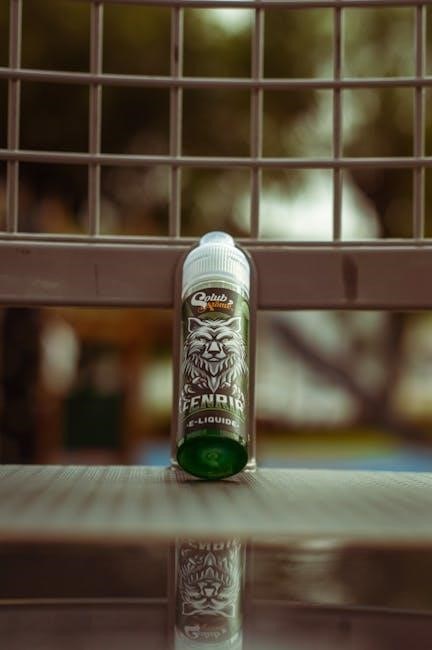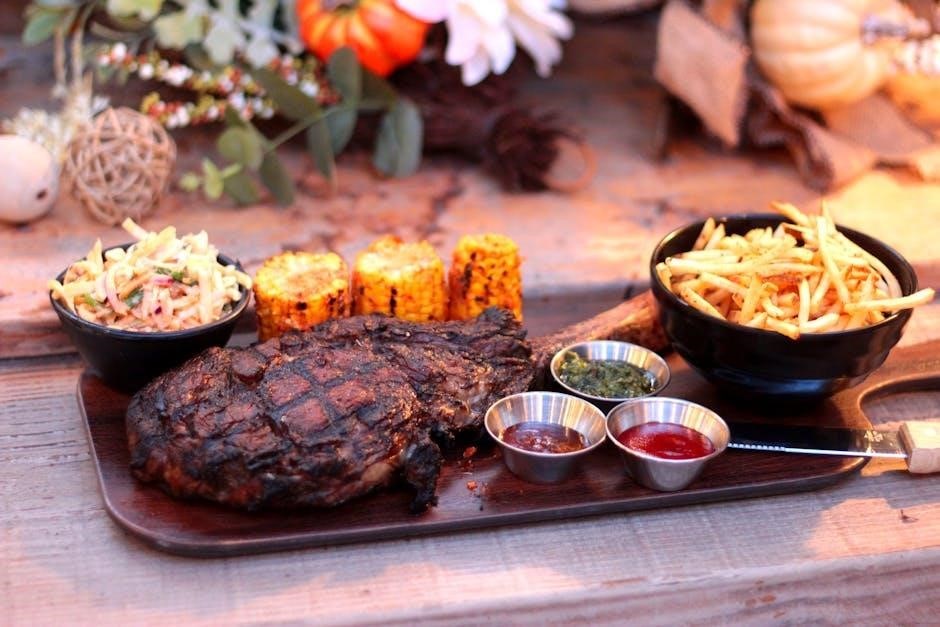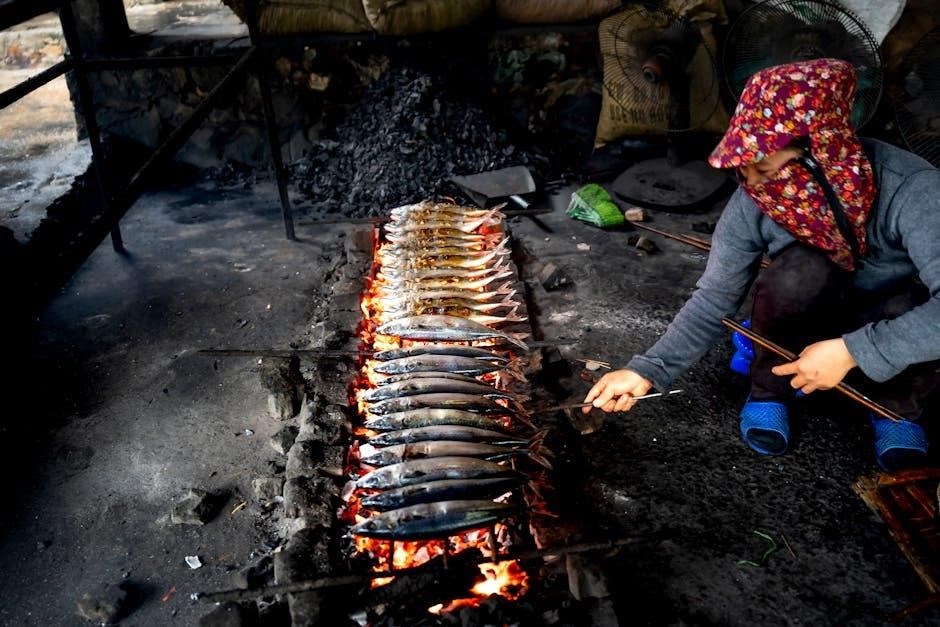
free bbq smoker plans pdf
Discover the world of backyard BBQ with free smoker plans PDFs, offering detailed DIY projects and guides to build custom smokers, perfect for enhancing your grilling experience.
What Are Free BBQ Smoker Plans?
Free BBQ smoker plans are downloadable guides that provide detailed instructions for building your own smoker at home. These PDF files typically include material lists, measurements, and step-by-step assembly instructions, making it easier for DIY enthusiasts to create a custom smoker. Suitable for both beginners and experienced builders, these plans often feature diagrams and customizable designs to suit various preferences and backyard spaces. They offer a cost-effective way to enjoy high-quality BBQ without purchasing expensive equipment. Available online, these plans empower users to craft smokers tailored to their needs, ensuring a flavorful and enjoyable grilling experience.
Why Build Your Own BBQ Smoker?
Building your own BBQ smoker offers cost savings, customization, and a sense of accomplishment. Homemade smokers can be tailored to specific needs, such as size, material, and features, ensuring optimal performance. DIY projects allow you to avoid the high costs of commercial smokers while learning valuable skills. Many free PDF plans are designed for accessibility, making the process achievable even for beginners. A custom-built smoker can enhance backyard gatherings, providing unique flavors and impressing friends. It’s a rewarding project that combines creativity with functionality, perfect for BBQ enthusiasts looking to elevate their grilling experience.
Benefits of Using Free PDF Plans
Free BBQ smoker PDF plans offer a cost-effective and accessible way to start your DIY project. These detailed guides provide step-by-step instructions, material lists, and measurements, ensuring clarity and ease of use. They cater to both beginners and experienced builders, allowing for customization to suit individual needs. PDF plans are easily downloadable and printable, making them convenient for reference. Many plans include visuals and tips, enhancing the building process. By using free resources, you can save money while creating a smoker tailored to your preferences, making it a practical and rewarding choice for backyard BBQ enthusiasts.

Tools and Materials Needed
Tools and materials like welders, drills, steel, and concrete are essential for building a durable and safe BBQ smoker, ensuring long-lasting performance and heat retention.
Essential Tools for Building a BBQ Smoker
Building a BBQ smoker requires essential tools like welders, drills, and saws for cutting and shaping metal. A tape measure, level, and wrench are crucial for precision and assembly. Steel brushes, sandpaper, and heat-resistant coatings ensure durability and safety. Materials such as steel plates, pipes, and concrete blocks are necessary for construction. A propane tank or drum can serve as the smoker chamber. Proper tools ensure a sturdy, functional, and long-lasting smoker design, while adhering to safety standards for optimal performance and flavor.
Materials Required for Construction
Building a BBQ smoker requires durable materials such as steel plates, pipes, and concrete blocks for the structure. Propane tanks or large drums are often repurposed as the smoker chamber due to their heat-retaining properties. Insulation materials like ceramic blankets or refractory insulation are essential for maintaining consistent temperatures. Heat-resistant coatings and seals prevent leaks and ensure safety. Additional components include grates, vents, and chimney pipes for airflow control. Having all materials ready ensures a smooth and successful construction process, resulting in a functional and long-lasting smoker.

Step-by-Step Guide to Building a BBQ Smoker
Follow detailed plans to build a smoker, starting with chamber preparation, constructing the smoking chamber, setting up ventilation, installing shelves, and final assembly for optimal performance.
Preparing the Chamber and Heat Source
Start by selecting a durable chamber, such as a propane tank, ensuring it’s heavy enough to retain heat. Clean and prepare the tank thoroughly, removing any residues. For the heat source, choose between charcoal, gas, or electric options, depending on your preference. Install vents to control airflow and temperature regulation. Weld the vent system to the chamber, ensuring proper sealing. Use heat-resistant materials to line the chamber and protect it from corrosion. This step is crucial for safety and efficiency, providing a stable environment for smoking. Proper preparation ensures even heat distribution and prevents potential hazards during use.
Constructing the Smoking Chamber
Constructing the smoking chamber involves assembling the main compartment where food will be smoked. Use durable materials like steel or brick for insulation and heat retention. Ensure the chamber is airtight to maintain consistent temperatures. Install racks or shelves to hold meats, and add access points for monitoring. Proper construction ensures even smoke circulation, enhancing flavor. Follow detailed plans to achieve precise measurements and secure connections. This step is vital for achieving optimal smoking performance and durability.
Setting Up Ventilation and Airflow
Proper ventilation and airflow are critical for efficient smoking. Install intake vents at the bottom and exhaust vents near the top to ensure smoke circulates evenly. Use dampers to control airflow, maintaining consistent temperatures. A well-designed ventilation system prevents smoke buildup and ensures meat cooks uniformly. Strategic placement of vents enhances smoke distribution, while a chimney or vent stack improves draft. Regular cleaning of vents prevents blockages. Follow plans to size vents correctly for your smoker’s dimensions. Proper airflow maximizes flavor and reduces the risk of over-smoking, ensuring a perfect BBQ experience.
Installing Shelves and Racks
Installing shelves and racks is essential for maximizing space and ensuring easy access to your smoked meats. Use durable materials like steel or food-grade wire for longevity. Position shelves at varying heights to accommodate different sizes of meat cuts. Ensure racks are removable for easy cleaning and maintenance. Adjustable shelves allow flexibility for various cooking needs. Secure racks firmly to prevent movement during smoking. Consider adding handles for easy access and optional dividers for organizing different meats. Proper installation ensures even smoke distribution and makes the smoking process more efficient and enjoyable. Follow the plan’s measurements for precise fitting and stability.
Final Assembly and Testing
After constructing the main components, carefully assemble the smoker by aligning and securing all parts according to the plan. Ensure chambers, vents, and doors fit tightly to maintain heat and smoke. Test the smoker by lighting a small fire to check for leaks and proper airflow. Verify that temperature controls function accurately and that smoke circulates evenly. Conduct a trial run with wood to assess performance and make adjustments if needed. Safety is crucial, so inspect all welds and connections for durability. Once satisfied, your homemade smoker is ready for its first BBQ adventure!
Safety Considerations
Ensure all welds are secure, and materials are heat-resistant. Proper ventilation is crucial to avoid gas buildup. Always follow safety guidelines when handling fire and high temperatures.
Important Safety Tips for DIY Smoker Builders
When building a DIY smoker, prioritize safety by using heat-resistant materials and ensuring proper ventilation. Secure all welds to prevent leaks and avoid using flammable coatings. Keep a fire extinguisher nearby and never build near flammable materials. Always follow local building codes and safety standards. Proper insulation and airflow are essential to prevent carbon monoxide buildup. Regularly inspect your smoker for damage or wear. By adhering to these guidelines, you can create a safe and functional BBQ smoker for enjoyable cooking experiences.

Ensuring Proper Ventilation
Proper ventilation is crucial for safe and efficient smoker operation. Ensure your design includes adequate intake and exhaust vents to maintain consistent airflow. This helps regulate temperature, prevent moisture buildup, and remove harmful gases. Install dampers to control airflow precisely, allowing for even heat distribution. A well-ventilated system minimizes the risk of incomplete combustion, which can produce harmful fumes. Always follow ventilation guidelines in your smoker plans to ensure optimal performance and safety. Proper airflow design is essential for achieving that perfect smoke flavor while keeping your cooking environment safe and enjoyable.

Heat-Resistant Materials and Coatings
Using heat-resistant materials and coatings is essential for building a durable and safe BBQ smoker. Steel is a popular choice due to its heat-retention properties, with thicknesses ranging from 3/16 to 1/4 inch recommended for optimal performance. Apply heat-resistant coatings or paints to protect the metal from corrosion and extreme temperatures. Insulation, such as ceramic blankets or refractory cement, can enhance heat retention and efficiency. Properly sealing gaps with heat-resistant gaskets ensures consistent temperatures and prevents smoke leakage. These materials and coatings not only extend the lifespan of your smoker but also improve cooking performance, ensuring delicious and evenly smoked meals every time.

Choosing the Right Design
Selecting the ideal BBQ smoker design involves considering space, fuel type, and personal preference. Explore options like offset, upright, or drum smokers to find your perfect match.
Popular Types of BBQ Smokers
When exploring free BBQ smoker plans, you’ll encounter various popular designs, each offering unique benefits. Offset smokers are a classic choice, separating the firebox from the cooking chamber for indirect heat. Upright or vertical smokers are space-efficient and ideal for smaller backyards. Drum smokers, often made from repurposed barrels, are budget-friendly and easy to build. Kamado grills, while more versatile, also function as smokers with precise temperature control. These designs cater to different needs, whether you’re a backyard enthusiast or a competitive pitmaster, ensuring there’s a smoker type to suit every preference and skill level.
Offset Smokers vs. Upright Smokers
Offset smokers and upright smokers are two popular designs with distinct features. Offset smokers have a separate firebox, allowing for indirect heat and better temperature control, ideal for slow cooking. Upright smokers, often vertical, save space and use gravity-fed systems for efficient smoking. Offset smokers are preferred by traditionalists for their classic smoke flavor, while upright models are great for backyard enthusiasts with limited space. Both designs appear in free BBQ smoker plans, offering builders flexibility to choose based on their preferences for performance, space, and smoking style.
Considerations for Backyard Space
When selecting a smoker design, backyard space plays a crucial role. Compact smokers are ideal for smaller areas, while larger models suit spacious yards. Vertical smokers save ground space, utilizing height for multiple racks. Portable smokers offer flexibility, allowing easy relocation. Ensure proper clearance for safety and ventilation. Measuring your available space beforehand helps in choosing the right size. Many free BBQ smoker plans cater to various yard sizes, ensuring backyard enthusiasts can enjoy smoking without compromising on flavor or functionality. Opt for a design that fits seamlessly into your outdoor setup, maximizing your grilling experience while maintaining practicality.

Tips for Success

Mastering your BBQ smoker involves patience, precise temperature control, and quality wood choices. Start with simple recipes, ensure proper ventilation, and maintain consistent heat for optimal results.
Common Mistakes to Avoid
When building your BBQ smoker, avoid using thin materials that can’t retain heat and ensure proper insulation to maintain consistent temperatures. Incorrect ventilation setups can lead to poor airflow, affecting smoke distribution and flavor. Neglecting to follow precise measurements from your plans may result in a poorly constructed smoker. Additionally, using low-quality or untreated wood can produce unwanted flavors and potentially harm your health. Regularly inspect and maintain your smoker to prevent rust and damage, ensuring longevity and optimal performance for your backyard cooking adventures.
Optimizing Performance and Flavor
Maximize your smoker’s performance by ensuring proper airflow and temperature control, essential for consistent cooking. Use high-quality wood varieties like hickory or mesquite for enhanced flavor profiles. Preseasoning your smoker before use prevents rust and ensures a clean taste. Regularly clean and maintain the interior to avoid residue buildup that can affect flavor. Experiment with different wood combinations and cooking times to achieve the perfect smoke. Properly sealing all gaps and joints in your DIY smoker will help retain heat and smoke, leading to tender and flavorful meats every time. These steps will elevate your BBQ game and impress your guests.
Maintenance and Upkeep
Regular maintenance is crucial to extend the life of your BBQ smoker; After each use, clean the grates and interior to prevent food residue buildup. Apply a food-safe rust inhibitor to metal parts to protect against corrosion. Check and replace worn-out seals to maintain heat efficiency. Store your smoker in a dry, covered area during off-season to shield it from harsh weather. Schedule annual deep cleans and inspections to ensure optimal performance. Proper upkeep ensures your smoker remains in top condition, delivering consistent results for years of delicious backyard BBQ experiences.

Where to Find Free BBQ Smoker Plans
Access free BBQ smoker plans PDFs through reputable websites like SmokerBuilder, DIY projects forums, and Instructables, offering detailed guides and blueprints for custom smoker builds.
Reputable Websites for Free Downloads
Find reliable free BBQ smoker plans PDFs on websites like SmokerBuilder, Instructables, and specialized DIY forums. These platforms offer detailed guides, blueprints, and material lists for various smoker designs; Many sites provide step-by-step instructions, ensuring even beginners can successfully build their smokers. Some popular options include plans for offset smokers, upright drum smokers, and barrel-based designs. These resources often include photos, diagrams, and user reviews to help you choose the perfect plan. Download these free PDFs to start your DIY project and create a custom smoker tailored to your backyard BBQ needs.
Communities and Forums for Support
Join online communities like Reddit’s DIY and BBQ forums, Facebook groups, and specialized platforms for smoker enthusiasts. These spaces offer valuable support, troubleshooting tips, and design feedback from experienced builders. Share your projects, ask questions, and gain insights from experts. Many forums also host free BBQ smoker plans PDFs, shared by passionate DIYers. Engage with these communities to refine your skills and stay updated on the latest trends and techniques in backyard smoking; They’re excellent resources for overcoming challenges and optimizing your smoker’s performance.

Advanced Techniques
Elevate your BBQ game with advanced techniques like customizing smoker designs and integrating smart technology for precise temperature control and enhanced flavor profiles.
Customizing Your Smoker Design
Customizing your smoker allows you to tailor its features to your specific needs. Start by choosing the size and layout that fits your backyard space. Consider adding unique features like adjustable racks, a rotisserie, or a built-in thermometer for precise temperature control. You can also incorporate recycled materials, such as an old propane tank, to create an eco-friendly and durable smoker. For advanced customization, integrate smart technology, such as Wi-Fi-enabled temperature controllers, to monitor and adjust your smoker remotely. These modifications not only enhance functionality but also add a personal touch to your DIY project, making it truly one-of-a-kind.
Incorporating Smart Technology
Incorporating smart technology into your DIY smoker enhances its performance and convenience. Consider adding Wi-Fi-enabled temperature controllers, allowing you to monitor and adjust heat levels via a smartphone app. Smart sensors can provide real-time feedback on meat temperature, ensuring perfectly smoked dishes. Voice command compatibility with smart home systems adds futuristic control. These upgrades streamline the smoking process, making it more efficient and enjoyable. Ensure your free BBQ smoker plans PDF includes space for these integrations, enabling a seamless blend of traditional craftsmanship and modern innovation for a superior grilling experience.
Creative Ideas
Transform your smoker with creative ideas like upcycling old appliances or adding unique features such as storage compartments, personalized engravings, or vibrant paint jobs for a custom look.
Upcycling Old Appliances
Upcycling old appliances into a BBQ smoker is a creative and eco-friendly approach. Many DIY enthusiasts use discarded items like old propane tanks, 55-gallon drums, or even refrigerators to create functional smokers. These materials are durable and can be transformed into unique smoking chambers with minimal cost. By repurposing these items, you not only reduce waste but also add a personal touch to your smoker. Ensure the appliances are thoroughly cleaned and modified to meet safety standards. This method is perfect for those who enjoy hands-on projects and want to save money while creating something truly original for their backyard BBQ setup.
Unique Features to Add
Enhance your BBQ smoker with unique features that set it apart from the ordinary. Consider adding a digital temperature control system for precise monitoring, multi-level racks for versatile cooking, or a built-in woodchip tray for consistent smoke flavor. Incorporate smart technology, such as Bluetooth or Wi-Fi connectivity, to control the smoker remotely via a smartphone app. Adding a side table or storage compartment can improve functionality. For a personal touch, customize the exterior with a durable, heat-resistant finish or decorative designs. These features not only boost performance but also make your DIY smoker a standout piece for backyard gatherings and barbecues.
Building your own BBQ smoker using free PDF plans is a rewarding project that enhances your grilling experience. Enjoy the fruits of your labor and happy cooking!
Enjoying Your Homemade BBQ Smoker
Once your DIY smoker is complete, the real fun begins! Imagine the satisfaction of smoking delicious meats using your own handmade equipment. Whether it’s tender brisket, flavorful ribs, or savory pulled pork, your homemade smoker will bring out the best in every dish. Invite friends and family to share in the enjoyment of authentic BBQ, crafted with love and care. The pride of creation combined with the joy of sharing a memorable meal makes this project truly rewarding. Savor the taste of your hard work and the smiles it brings to everyone who gathers around the table.
Final Thoughts and Encouragement
Embrace the journey of building your own BBQ smoker with confidence! Free PDF plans provide a clear roadmap, making the process accessible and enjoyable. Don’t be afraid to experiment and personalize your design—every smoker tells a unique story. The sense of accomplishment from creating something with your own hands is incredibly fulfilling. Share your experiences, learn from others, and continue refining your craft. BBQ is more than food; it’s a way to connect and create lasting memories. Dive in, get creative, and enjoy the delicious fruits of your labor with family and friends. Happy building and smoking!